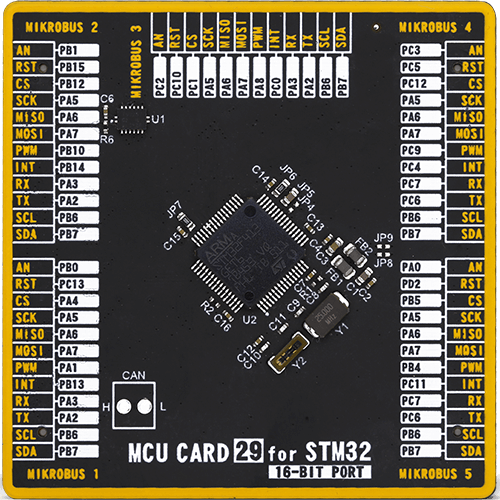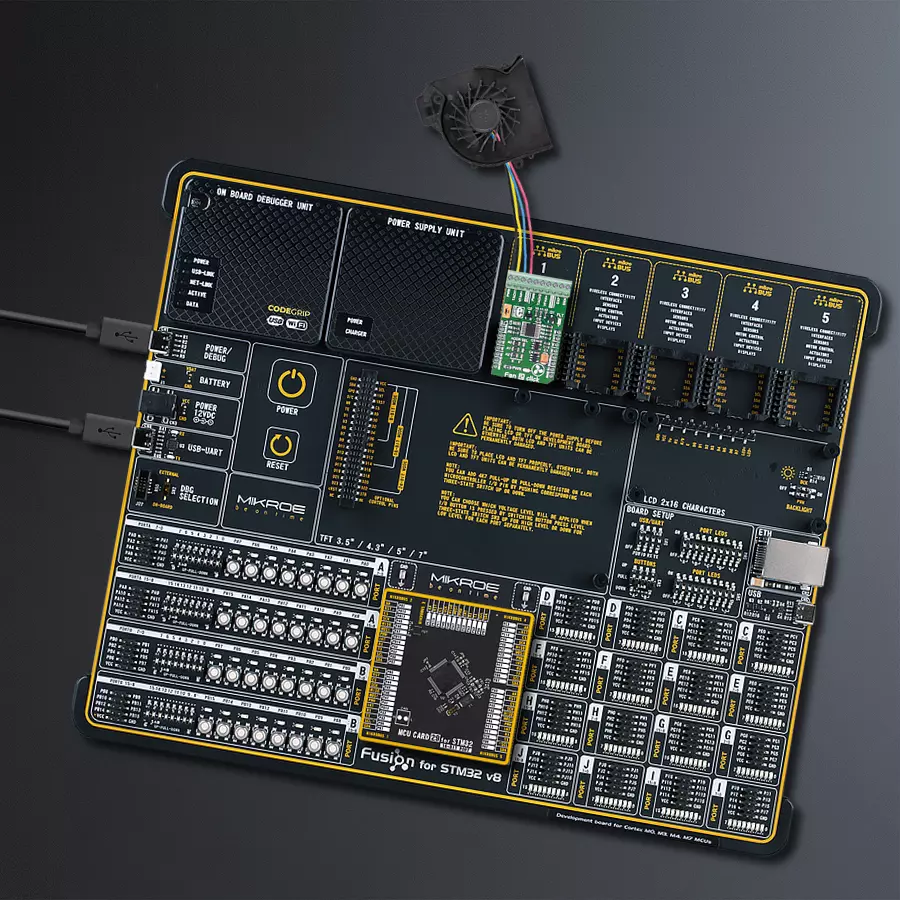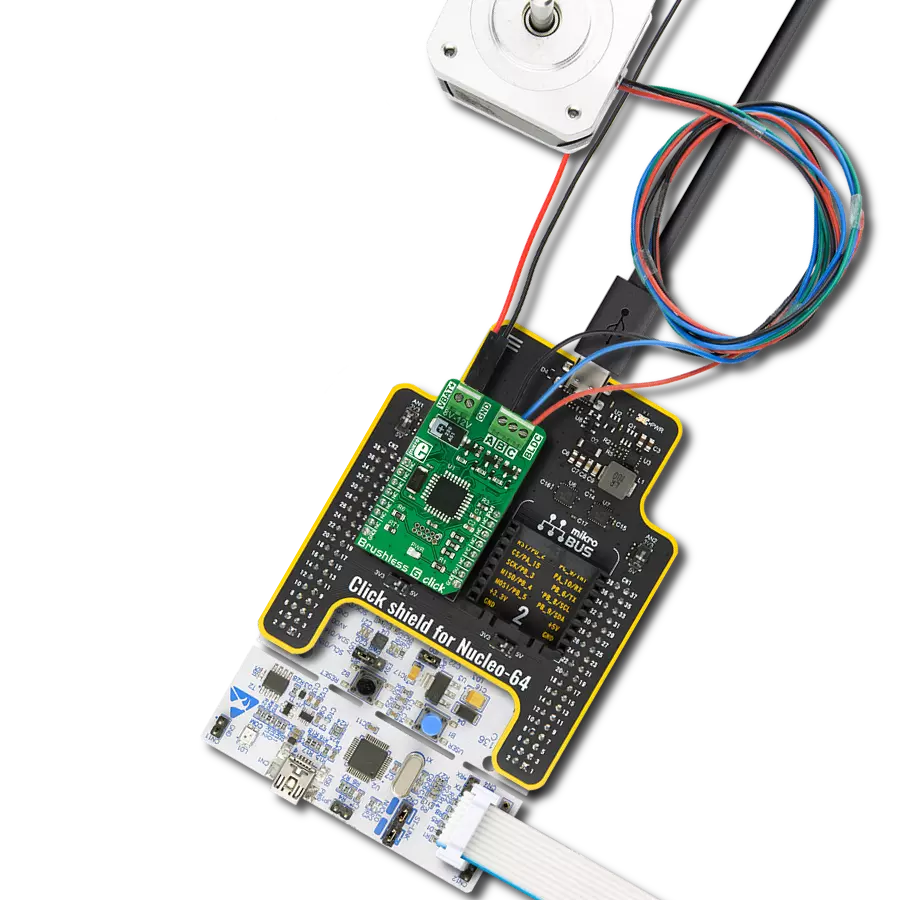Command your fans with precision and finesse
A
A
Hardware Overview
How does it work?
Fan 2 Click is based on the MAX31760, a precision fan-speed controller from Analog Devices. It can measure temperature and adjust the fan speed to keep the temperature at the same level. Fan 2 Click can also control two fans at the same time. This Click board™ is designed to run on either 3.3V or 5V power supply. It communicates with the target microcontroller over the I2C interface, with additional functionality provided by the following pins on the mikroBUS™ line: INT, AN, RST, and CS. For example, you can set the limit at 25°C, and if the temperature goes over that, the Click board™ will activate the fan; it will keep working until the temperature is 25°C again. The MAX31760 integrates temperature sensing along with
precision PWM fan control. It accurately measures its local die temperature and the remote temperature of a discrete diode-connected transistor, such as a 2N3906 or a thermal diode commonly found on CPUs, graphics processor units (GPUs), and other ASICs. Multiple temperature thresholds, such as local high/overtemperature (OT) and remote high/overtemperature, can be set by an I2C-compatible interface. Fan speed is controlled based on the temperature reading as an index to a 48-byte lookup table (LUT) containing user-programmed PWM values. The flexible LUT-based architecture enables users to program a smooth nonlinear fan speed vs. temperature transfer
function to minimize acoustic fan noise. Two tachometer inputs allow for measuring the speeds of two fans independently. The Click board™ carries a 10-pole terminal block that allows easy connection for pairs of two, three, or four-wire DC fans on the standard way of connection via PWM, TACH, GND, and VFAN lines. A single onboard jumper setting enables a two or 3-wire fan connection. In addition, there are two points (DXP, DXN) on the same terminal for external temperature sensor connection. The click communicates with the MCU over a data interface voltage level of 3.3V only.
Features overview
Development board
Fusion for STM32 v8 is a development board specially designed for the needs of rapid development of embedded applications. It supports a wide range of microcontrollers, such as different 32-bit ARM® Cortex®-M based MCUs from STMicroelectronics, regardless of their number of pins, and a broad set of unique functions, such as the first-ever embedded debugger/programmer over WiFi. The development board is well organized and designed so that the end-user has all the necessary elements, such as switches, buttons, indicators, connectors, and others, in one place. Thanks to innovative manufacturing technology, Fusion for STM32 v8 provides a fluid and immersive working experience, allowing
access anywhere and under any circumstances at any time. Each part of the Fusion for STM32 v8 development board contains the components necessary for the most efficient operation of the same board. An advanced integrated CODEGRIP programmer/debugger module offers many valuable programming/debugging options, including support for JTAG, SWD, and SWO Trace (Single Wire Output)), and seamless integration with the Mikroe software environment. Besides, it also includes a clean and regulated power supply module for the development board. It can use a wide range of external power sources, including a battery, an external 12V power supply, and a power source via the USB Type-C (USB-C) connector.
Communication options such as USB-UART, USB HOST/DEVICE, CAN (on the MCU card, if supported), and Ethernet is also included. In addition, it also has the well-established mikroBUS™ standard, a standardized socket for the MCU card (SiBRAIN standard), and two display options for the TFT board line of products and character-based LCD. Fusion for STM32 v8 is an integral part of the Mikroe ecosystem for rapid development. Natively supported by Mikroe software tools, it covers many aspects of prototyping and development thanks to a considerable number of different Click boards™ (over a thousand boards), the number of which is growing every day.
Microcontroller Overview
MCU Card / MCU

Type
8th Generation
Architecture
ARM Cortex-M4
MCU Memory (KB)
1536
Silicon Vendor
STMicroelectronics
Pin count
64
RAM (Bytes)
327680
Used MCU Pins
mikroBUS™ mapper
Take a closer look
Click board™ Schematic

Step by step
Project assembly
Track your results in real time
Application Output
1. Application Output - In Debug mode, the 'Application Output' window enables real-time data monitoring, offering direct insight into execution results. Ensure proper data display by configuring the environment correctly using the provided tutorial.

2. UART Terminal - Use the UART Terminal to monitor data transmission via a USB to UART converter, allowing direct communication between the Click board™ and your development system. Configure the baud rate and other serial settings according to your project's requirements to ensure proper functionality. For step-by-step setup instructions, refer to the provided tutorial.

3. Plot Output - The Plot feature offers a powerful way to visualize real-time sensor data, enabling trend analysis, debugging, and comparison of multiple data points. To set it up correctly, follow the provided tutorial, which includes a step-by-step example of using the Plot feature to display Click board™ readings. To use the Plot feature in your code, use the function: plot(*insert_graph_name*, variable_name);. This is a general format, and it is up to the user to replace 'insert_graph_name' with the actual graph name and 'variable_name' with the parameter to be displayed.

Software Support
Library Description
This library contains API for Fan 2 Click driver.
Key functions:
fan2_generic_write_byte- Generic Byte Write functionfan2_read_tacho- Tachometer Read functionfan2_direct_speed_control- Direct Fan Speed Control function
Open Source
Code example
The complete application code and a ready-to-use project are available through the NECTO Studio Package Manager for direct installation in the NECTO Studio. The application code can also be found on the MIKROE GitHub account.
/*!
* \file main.c
* \brief Fan 2 Click example
*
* # Description
* This example demonstrates the use of Fan 2 Click board.
* It demonstrates sensor measurements and fan control.
*
* The demo application is composed of two sections :
*
* ## Application Init
* Initializes I2C driver and executes a default configuration for Fan 2 Click.
* Also initializes UART logger for results logging.
*
* ## Application Task
* Increments the fan speed from half speed to maximum, and on each step measures
* the current fan speed in RPM and the remote temperature in Celsius.
* Fan speed will be incremented/decremented each second for 10 percents.
*
* \author Nemanja Medakovic
*
*/
// ------------------------------------------------------------------- INCLUDES
#include "board.h"
#include "log.h"
#include "fan2.h"
// ------------------------------------------------------------------ VARIABLES
static fan2_t fan2;
static log_t logger;
static float fan2_speed;
static uint16_t fan2_curr_speed;
static float fan2_temp;
static uint8_t flag;
static char deg_cels[ 3 ] = { 176, 'C', 0 };
// ------------------------------------------------------ APPLICATION FUNCTIONS
void application_init( void )
{
fan2_cfg_t fan2_cfg;
log_cfg_t log_cfg;
/**
* Logger initialization.
* Default baud rate: 115200
* Default log level: LOG_LEVEL_DEBUG
* @note If USB_UART_RX and USB_UART_TX
* are defined as HAL_PIN_NC, you will
* need to define them manually for log to work.
* See @b LOG_MAP_USB_UART macro definition for detailed explanation.
*/
LOG_MAP_USB_UART( log_cfg );
log_init( &logger, &log_cfg );
log_info( &logger, "---- Application Init ----" );
// Click initialization.
fan2_cfg_setup( &fan2_cfg );
FAN2_MAP_MIKROBUS( fan2_cfg, MIKROBUS_1 );
fan2_init( &fan2, &fan2_cfg );
fan2_default_cfg( &fan2 );
fan2_speed = FAN2_HALF_SPEED_PER;
Delay_ms ( 1000 );
log_printf( &logger, "* * * Fan 2 initialization done * * *\r\n" );
log_printf( &logger, "***************************************\r\n" );
flag = 0;
}
void application_task( void )
{
fan2_direct_speed_control( &fan2, fan2_speed );
Delay_ms ( 1000 );
fan2_read_tacho( &fan2, FAN2_REG_TACH1_CNT, &fan2_curr_speed );
fan2_read_temp( &fan2, FAN2_REG_REMOTE_TEMP_READ, &fan2_temp );
log_printf( &logger, "* Fan 2 set speed : %.2f %%\r\n", fan2_speed );
log_printf( &logger, "* Fan 2 current speed : %u RPM\r\n", fan2_curr_speed );
log_printf( &logger, "* Fan 2 remote temperature : %.2f %s\r\n", fan2_temp, deg_cels );
log_printf( &logger, "***************************************\r\n" );
if ( flag == 0 ) {
if ( fan2_speed < FAN2_MAX_SPEED_PER)
fan2_speed += 10;
else
flag = 1;
}
if ( flag == 1 ) {
if ( fan2_speed > FAN2_MIN_SPEED_PER)
fan2_speed -= 10;
else {
fan2_speed = FAN2_HALF_SPEED_PER;
flag = 0;
}
}
}
int main ( void )
{
/* Do not remove this line or clock might not be set correctly. */
#ifdef PREINIT_SUPPORTED
preinit();
#endif
application_init( );
for ( ; ; )
{
application_task( );
}
return 0;
}
// ------------------------------------------------------------------------ END

































